Advertisement
Converging technologies forged through years of research and testing are producing a new breed of boats we’ve experienced in several sea trials. Plus, so many smart advances
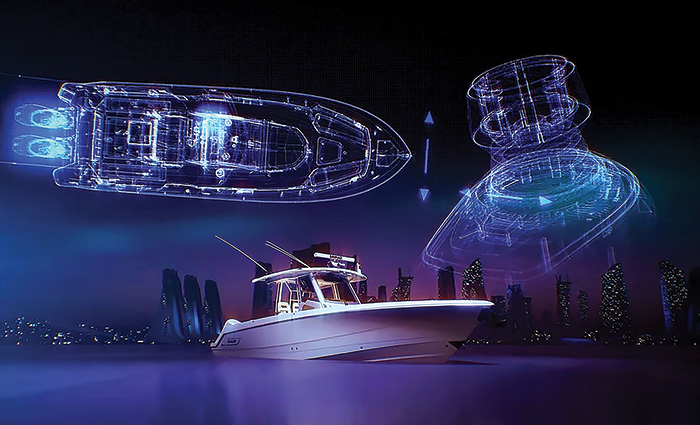
Coming soon to a showroom near you: AI-assisted docking/undocking and joystick driving. Photo: Brunswick
It’s time to scuttle the assumption that change comes slowly to our cozy, little pleasure boating world. Technological innovation is coming so fast these days, it’s hard to keep up – even for BoatU.S. Magazine editors determined to keep members informed of what’s new out on the water. In our Nov./Dec. issue, we reported on the integration of Artificial Intelligence in boat systems that could, in theory, autonomously navigate open and ever-changing water safely, with a human skipper standing by at the ready to take over at any time.
We also questioned the entire concept of trusting a computer “brain” to make complex judgments in an ever-changing environment. Automobiles can follow painted lines on solid pavement, sense and warn about nearby objects, and even brake if the driver doesn’t. Drivers are trained and licensed. Boating has none of these traits, so there’s plenty of proving to be done for these emerging technologies.
The commercial shipping industry is just starting to use fully autonomous ocean-crossing cargo ships, but a fully autonomous recreational boat doesn’t exist yet. And the Korean software developer Avikus, now negotiating with boatbuilders to integrate its AI software into recreational boat systems, says that level of autonomous navigation won’t be found in your local dealer showroom any time soon. What we’re seeing now are boats with some degree of autonomy, and an AI system that’s already impressive, even in its early stages.
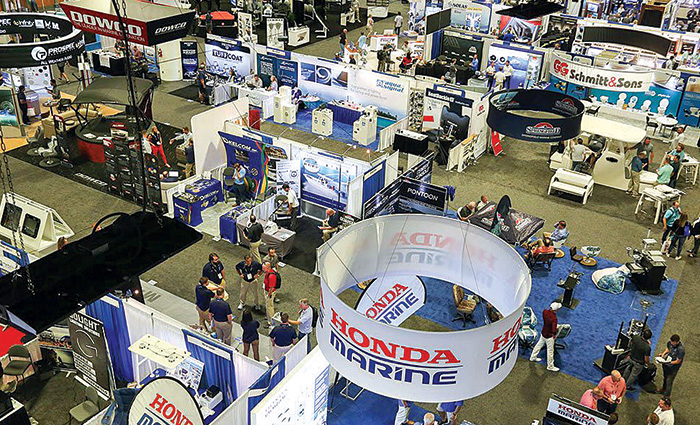
Every booth at IBEX sells a different widget for your boat. Photo: RIch Armstrong

Hempel Silic One fouling release paint Photo: Rich Armstrong
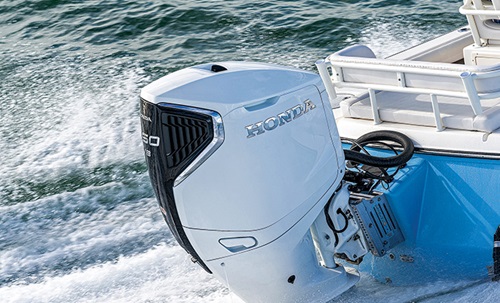
Honda BF350. Photo: Rich Armstrong
Tech on display
The International Boatbuilders Exhibition (IBEX) is a different kind of boat show — one just for companies that build, design, service, or sell boats or marine products. IBEX is a B2B showcase held every October in Tampa, Florida, and it’s a must-see for BoatU.S. Magazine because it’s our first look at products coming soon to the market. Here’s what caught our eye at IBEX.
- Honda Marine (marine.honda.com) is known more for its small- to mid-range outboard engines, but the new BF350 is both its first V8 and, it says, most technologically advanced outboard. Honda claims the BF350 will deliver 20% better fuel economy over comparable outboards and promise design improvements to provide a flatter torque curve, smoother power delivery throughout the operating range, ergonomically designed controls, and improved reliability and maintenance. Perhaps most notably, Honda claims that this high-tech machine can be run on standard 87-octane gasoline, offering the potential for big savings at the fuel pump. We found this four-stroke to be on par with the quietest outboard while underway.
- From Denmark comes Hempel Silic One (hempelyacht.com), a copper-free, biocide-free antifouling coating unlike any other on the market. “We’re not selling antifouling paint. We’re selling fouling release paint,” explains product manager Joe Graves.
That’s because Silic One’s nonreactive polymers create an invisible barrier between the hull’s surface and the water, fooling marine life into believing the hull is liquid and significantly reducing their attachment. Growth literally wipes off the hull with no scrubbing required because growth starts to slide off at 5 knots of speed, according to Hempel.
The three-layer application has proven effective in cold, temperate, and warm water temperatures, according to Hempel. Each application will last two seasons, the company says, and requires no sanding before simply applying another coat over the existing coating. Boaters who choose Silic One can repeat that low-maintenance process five times, meaning 10 years, without the need to sand the hull. The product has been on the European recreational boating market for five years and was the only product to earn five stars from Practical Boat Owner Magazine in the U.K. SeaWide Distribution, the U.S. distributor, only sells commercially, so start with your local boatyard. — R.A.
Sea trial of an AI prototype
Last fall, Brunswick invited BoatU.S. Magazine to Chelsea Piers on New York City’s busy Hudson River. We climbed aboard a 40-foot Boston Whaler 405 Conquest rigged with a prototype autonomous docking system so new it doesn’t have a name yet. Brunswick says it has spent a decade developing the interconnected system that combines six stereo cameras mounted around the boat for 360-degree vision. Brunswick says it also utilizes laser-sensing monitors that measure variable distances, GPS tracking, integrated bow thruster, and outboard control all tied into a high-processing computer.
“This is a machine-learning system,” explained Brandon Ferriman, program director of Autonomy and ADAS Programs for Brunswick. “It’s comprehending the entire world around it and continually mapping out the perimeter.”
Ferriman makes the point that today’s machines can process data faster than any human skipper and never get flustered, tired, or distracted. AI is the science of making computers and machines that, in theory, can quickly learn and react in a way that simulates human intelligence.
But we’re still leery of assigning any sentient “thoughts” to a machine, or of allowing a machine to make value judgments when there are decisions to be made about maneuvering among other boats, marine obstacles, natural phenomena, and thought processes of other vessel operators, even if the skipper can override the system at any time. For example, can the system make value judgments between the situation where a fender is hanging over the side waiting to be crushed, or a leg? We went to the sea trial with a lot of questions.
The unveiling was for a product Brunswick expects to bring to market in model year 2025. We were on-board observers as the team pushed a few touchscreen buttons, pointed on the display to a spot in the marina channel where they wanted the boat to park itself, then stepped back to let the boat maneuver out of a tight slip with little wiggle room for a 90-degree turn into the channel. Adding to the challenge, the waters off Manhattan are bustling with commercial traffic that continually sent rolling wakes into the marina.
From our experience, the boat handled the challenging situation well, alternating thruster, engine, and steering to execute the complex back-and-forth maneuver, leaving the boat idling stationary in the channel with its bow pointed toward the marina exit. Then a few more buttons were pressed, and the boat did the process in reverse – also flawlessly – as our skipper stood by the helm as a spectator. It was impressive and a little surreal to witness, even if it was just in the controlled situation of a marina (we didn’t sea trial the system in open water with its myriad unexpected conditions and other boat traffic).
The Brunswick system will join Volvo Penta’s Assisted Docking system (which cannot disembark from the dock) and Avikus, which has partnered with Raymarine on a third docking system (see “Artificial Intelligence On Board,” Boats Gear Tech, Nov./Dec. 2023) expected on select yachts this year, including Princess, San Lorenzo, and Beneteau. Initial pricing is bound to be out of reach for most of us, but technology does trickle down over time.
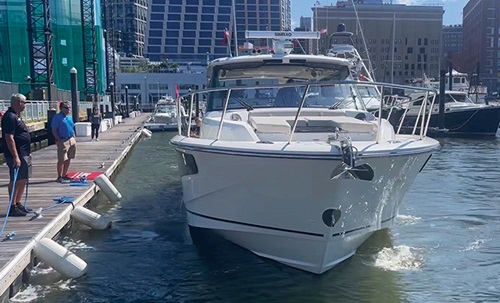
Brunswick demonstrated its new AI docking technology to the media. Photo: Rich Armstrong
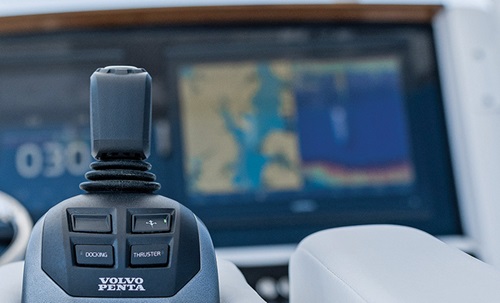
Volvo Penta has integrated both steering and throttle control into a joystick. Photo: Rich Armstrong
Steering wheel optional
A few weeks later, Volvo Penta invited us to sea trial its latest technology – Joystick Driving. Experienced boaters will remember that Volvo introduced joysticks to boats back in 2006, and the finger-touch control system has since proliferated the boating industry and revolutionized docking in close quarters. Volvo hasn’t done away with the throttle and steering wheel, but from what we previewed, the skipper doesn’t need to drive the boat by joystick alone either. Note that Volvo Penta Joystick Steering has been an option since 2012. Joystick Driving integrates throttle control in the stick.
At the helm of a Southport 30 FE center-console with a single D6 diesel sterndrive, we carved serpentine wakes and tight circles in Tampa Bay, throttling up and down just by maneuvering the joystick mounted on the helm seat arm rest. The handling was intuitive – push the joystick forward to engage the gear, speed up, back to slow down, and release it to hold speed. However, we couldn’t help but wonder about an involuntary release by a slippery hand and also how steering by stick would feel in the challenge of quartering and following seas. Some wonder how you are going to “feel the sea” with this and related technology. Isn’t feeling the sea a huge part of safely running the boat?
Look for Volvo Steering as an option on 2024 sterndrive boats from Cruisers Yachts, Southport, Sabre, Tiara, and Cutwater Boats.
Eyes on the horizon
The unavoidable question with this still-evolving, complex, cutting-edge technology is, “What happens when the system fails?” Manufacturers are adamant about the continual need for human oversight during operation and that skippers need to know how to handle all maneuvers and navigation themselves. This takes seamanship, education, training, and lots of practice. But how many humans are going to get this when AI is doing it all for them?
With all these new technologies, there are still major hurdles in the form of safety standards and legal compliance to be cleared. BoatU.S. Magazine will continue to follow marine autonomous technology developments in the months and years ahead with a sharp eye for your safety. As always, BoatU.S. will continue to promote boater education, legal compliance, and safe boat operation on the water.
